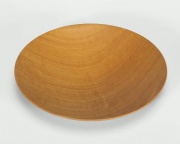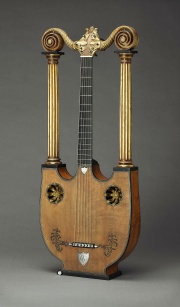Difference between revisions of "Satinwood"
| Line 4: | Line 4: | ||
1) A silky, golden-color wood obtained from the deciduous satinwood tree, ''Chloroxylon swietenia'', native to India, Madagascar, Sri Lanka and the East Indies. Satinwood timber has a fine interlocked grain with a uniform texture. Quarter sawn pieces have a narrow stripe figuring. The durable wood is used for furniture, veneer, cabinetry, turnery and small articles. Populations are in decline due to exploitation. | 1) A silky, golden-color wood obtained from the deciduous satinwood tree, ''Chloroxylon swietenia'', native to India, Madagascar, Sri Lanka and the East Indies. Satinwood timber has a fine interlocked grain with a uniform texture. Quarter sawn pieces have a narrow stripe figuring. The durable wood is used for furniture, veneer, cabinetry, turnery and small articles. Populations are in decline due to exploitation. | ||
| − | 2) A lustrous, dark yellow wood from the evergreen satinwood tree, ''Zanthoxylum flavum'' (South America, the Caribbean islands, and Africa). This oily timber has a close, irregular grain, smells like coconut and polishes to a high gloss. This satinwood is used for similar applications as East Indian satinwood. | + | 2) A lustrous, dark yellow wood from the evergreen satinwood tree, ''Zanthoxylum flavum'' (South America, the Caribbean islands, and Africa). This oily timber has a close, irregular grain, smells like coconut and polishes to a high gloss. This satinwood is used for similar applications as East Indian satinwood. This species is also threatened due to habitat loss and excess harveting. |
[[File:2000.972-SC19730.jpg|thumb|]] | [[File:2000.972-SC19730.jpg|thumb|]] | ||
| + | |||
== Synonyms and Related Terms == | == Synonyms and Related Terms == | ||
Revision as of 13:53, 4 October 2020
Description
1) A silky, golden-color wood obtained from the deciduous satinwood tree, Chloroxylon swietenia, native to India, Madagascar, Sri Lanka and the East Indies. Satinwood timber has a fine interlocked grain with a uniform texture. Quarter sawn pieces have a narrow stripe figuring. The durable wood is used for furniture, veneer, cabinetry, turnery and small articles. Populations are in decline due to exploitation.
2) A lustrous, dark yellow wood from the evergreen satinwood tree, Zanthoxylum flavum (South America, the Caribbean islands, and Africa). This oily timber has a close, irregular grain, smells like coconut and polishes to a high gloss. This satinwood is used for similar applications as East Indian satinwood. This species is also threatened due to habitat loss and excess harveting.
Synonyms and Related Terms
1: Chloroxylon swietenia; Ceylon satinwood; flowered satinwood; East Indian satinwood
2: Zanthoxylum flavum Brazilian satinwood; West Indian satinwood; concha satinwood; African satinwood; yellow sander; tembetaria; yellow sandalwood
Physical and Chemical Properties
Density = 50-60 ppcf
Additional Images
Resources and Citations
- G.S.Brady, Materials Handbook, McGraw-Hill Book Co., New York, 1971 Comment: p. 381
- Ralph Mayer, A Dictionary of Art Terms and Techniques, Harper and Row Publishers, New York, 1969 (also 1945 printing)
- F. H. Titmuss, Commercial Timbers of the World, The Technical Press Ltd., London, 1965 Comment: 50-60 ppcf
- Michael McCann, Artist Beware, Watson-Guptill Publications, New York City, 1979
- George Savage, Art and Antique Restorer's Handbook, Rockliff Publishing Corp, London, 1954
- Dictionary of Building Preservation, Ward Bucher, ed., John Wiley & Sons, Inc., New York City, 1996
- Random House, Webster's Encyclopedic Unabridged Dictionary of the English Language, Grammercy Book, New York, 1997
- The American Heritage Dictionary or Encarta, via Microsoft Bookshelf 98, Microsoft Corp., 1998
- CRC Handbook of Chemistry and Physics, Robert Weast (ed.), CRC Press, Boca Raton, Florida, v. 61, 1980 Comment: density=59 ppcf (0.95 g/cm3)





